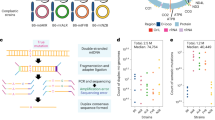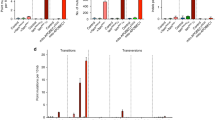Abstract
Whether mitochondrial mutations cause mammalian aging, or are merely correlated with it, is an area of intense debate1. Here, we use a new, highly sensitive assay2 to redefine the relationship between mitochondrial mutations and age. We measured the in vivo rate of change of the mitochondrial genome at a single–base pair level in mice, and we demonstrate that the mutation frequency in mouse mitochondria is more than ten times lower than previously reported. Although we observed an 11-fold increase in mitochondrial point mutations with age, we report that a mitochondrial mutator mouse3 was able to sustain a 500-fold higher mutation burden than normal mice, without any obvious features of rapidly accelerated aging. Thus, our results strongly indicate that mitochondrial mutations do not limit the lifespan of wild-type mice.
This is a preview of subscription content, access via your institution
Access options
Subscribe to this journal
Receive 12 print issues and online access
$209.00 per year
only $17.42 per issue
Buy this article
- Purchase on Springer Link
- Instant access to full article PDF
Prices may be subject to local taxes which are calculated during checkout




Similar content being viewed by others
References
Khrapko, K., Kraytsberg, Y., de Grey, A.D., Vijg, J. & Schon, E.A. Does premature aging of the mtDNA mutator mouse prove that mtDNA mutations are involved in natural aging? Aging Cell 5, 279–282 (2006).
Bielas, J.H. & Loeb, L.A. Quantification of random genomic mutations. Nat. Methods 2, 285–290 (2005).
Kujoth, G.C. et al. Mitochondrial DNA mutations, oxidative stress, and apoptosis in mammalian aging. Science 309, 481–484 (2005).
Saraste, M. Oxidative phosphorylation at the fin de siecle. Science 283, 1488–1493 (1999).
Newmeyer, D.D. & Ferguson-Miller, S. Mitochondria: releasing power for life and unleashing the machineries of death. Cell 112, 481–490 (2003).
Wallace, D.C. A mitochondrial paradigm of metabolic and degenerative diseases, aging, and cancer: a dawn for evolutionary medicine. Annu. Rev. Genet. 39, 359–407 (2005).
Trifunovic, A. Mitochondrial DNA and ageing. Biochim. Biophys. Acta 1757, 611–617 (2006).
Balaban, R.S., Nemoto, S. & Finkel, T. Mitochondria, oxidants, and aging. Cell 120, 483–495 (2005).
Miquel, J., Economos, A.C., Fleming, J. & Johnson, J.E., Jr. Mitochondrial role in cell aging. Exp. Gerontol. 15, 575–591 (1980).
Khrapko, K. et al. Mitochondrial mutational spectra in human cells and tissues. Proc. Natl. Acad. Sci. USA 94, 13798–13803 (1997).
Michikawa, Y., Mazzucchelli, F., Bresolin, N., Scarlato, G. & Attardi, G. Aging-dependent large accumulation of point mutations in the human mtDNA control region for replication. Science 286, 774–779 (1999).
Copeland, W.C. Mitochondrial DNA: methods and protocols. Methods Mol. Biol. 197, v–vi (2002).
Zhang, D. et al. Construction of transgenic mice with tissue-specific acceleration of mitochondrial DNA mutagenesis. Genomics 69, 151–161 (2000).
Bielas, J.H., Loeb, K.R., Rubin, B.P., True, L.D. & Loeb, L.A. Human cancers express a mutator phenotype. Proc. Natl. Acad. Sci. USA 103, 18238–18242 (2006).
Schriner, S.E. et al. Extension of murine life span by overexpression of catalase targeted to mitochondria. Science 308, 1909–1911 (2005).
Mandavilli, B.S., Santos, J.H. & Van Houten, B. Mitochondrial DNA repair and aging. Mutat. Res. 509, 127–151 (2002).
Wang, D., Kreutzer, D.A. & Essigmann, J.M. Mutagenicity and repair of oxidative DNA damage: insights from studies using defined lesions. Mutat. Res. 400, 99–115 (1998).
Kreutzer, D.A. & Essigmann, J.M. Oxidized, deaminated cytosines are a source of C → T transitions in vivo. Proc. Natl. Acad. Sci. USA 95, 3578–3582 (1998).
Pinz, K.G., Shibutani, S. & Bogenhagen, D.F. Action of mitochondrial DNA polymerase gamma at sites of base loss or oxidative damage. J. Biol. Chem. 270, 9202–9206 (1995).
Tanaka, M. & Ozawa, T. Strand asymmetry in human mitochondrial DNA mutations. Genomics 22, 327–335 (1994).
Frederico, L.A., Kunkel, T.A. & Shaw, B.R. A sensitive genetic assay for the detection of cytosine deamination: determination of rate constants and the activation energy. Biochemistry 29, 2532–2537 (1990).
Trifunovic, A. et al. Premature ageing in mice expressing defective mitochondrial DNA polymerase. Nature 429, 417–423 (2004).
Larsen, N.B., Rasmussen, M. & Rasmussen, L.J. Nuclear and mitochondrial DNA repair: similar pathways? Mitochondrion 5, 89–108 (2005).
Elson, J.L., Samuels, D.C., Turnbull, D.M. & Chinnery, P.F. Random intracellular drift explains the clonal expansion of mitochondrial DNA mutations with age. Am. J. Hum. Genet. 68, 802–806 (2001).
Bender, A. et al. High levels of mitochondrial DNA deletions in substantia nigra neurons in aging and Parkinson disease. Nat. Genet. 38, 515–517 (2006).
Kraytsberg, Y. et al. Mitochondrial DNA deletions are abundant and cause functional impairment in aged human substantia nigra neurons. Nat. Genet. 38, 518–520 (2006).
Tyynismaa, H. et al. Mutant mitochondrial helicase Twinkle causes multiple mtDNA deletions and a late-onset mitochondrial disease in mice. Proc. Natl. Acad. Sci. USA 102, 17687–17692 (2005).
Hamilton, M.L. et al. Does oxidative damage to DNA increase with age? Proc. Natl. Acad. Sci. USA 98, 10469–10474 (2001).
Acknowledgements
This work was supported by US National Institutes of Health grants AG001751 (L.A.L., P.S.R.), CA102029 (L.A.L.), ES11045 (L.A.L., W.C.L.) and AG021905 (T.A.P., G.C.K.). J.H.B. was supported by a research fellowship from the Canadian Institutes of Health. The authors thank G.M. Martin, R.S. Mangalindan, R.N. Venkatesan and C.-Y. Chen for editing this manuscript, technical assistance and discussions.
Author information
Authors and Affiliations
Contributions
M.V. carried out all the experiments described and wrote the paper. M.V., J.H.B. and L.A.L. conceived the project. G.C.K. and T.A.P. provided Kaplan-Meier curves and statistical analysis of mouse cohorts. J.H.B., W.C.L., G.C.K., T.A.P. and P.S.R. provided technical assistance, animal care and tissues. L.A.L. supervised the experimental work and interpretation of data. All authors commented on and discussed the paper.
Corresponding author
Ethics declarations
Competing interests
The authors declare no competing financial interests.
Supplementary information
Supplementary Fig. 1
RMC protocol. (PDF 182 kb)
Supplementary Fig. 2
PCR artificially raises the mutation frequency. (PDF 93 kb)
Supplementary Fig. 3
Treatment of mtDNA with hydrogen peroxide does not affect the performance of the RMC assay. (PDF 78 kb)
Supplementary Fig. 4
Decreased mutation frequency in hearts of mCAT animals (PDF 50 kb)
Supplementary Fig. 5
Mutation spectra of wild-type, exonuclease-deficient and mCAT animals. (PDF 85 kb)
Supplementary Fig. 6
Mutation frequencies at three additional loci in Polg+/mut mice. (PDF 99 kb)
Supplementary Table 1
Control and TaqI flanking primers. (PDF 39 kb)
Rights and permissions
About this article
Cite this article
Vermulst, M., Bielas, J., Kujoth, G. et al. Mitochondrial point mutations do not limit the natural lifespan of mice. Nat Genet 39, 540–543 (2007). https://doi.org/10.1038/ng1988
Received:
Accepted:
Published:
Issue Date:
DOI: https://doi.org/10.1038/ng1988
This article is cited by
-
NAD+ dependent UPRmt activation underlies intestinal aging caused by mitochondrial DNA mutations
Nature Communications (2024)
-
Distinguishing between driver and passenger mechanisms of aging
Nature Genetics (2024)
-
Secondary structure of the human mitochondrial genome affects formation of deletions
BMC Biology (2023)
-
Mitochondrial links between brain aging and Alzheimer’s disease
Translational Neurodegeneration (2021)
-
Structural basis of DNA synthesis opposite 8-oxoguanine by human PrimPol primase-polymerase
Nature Communications (2021)



